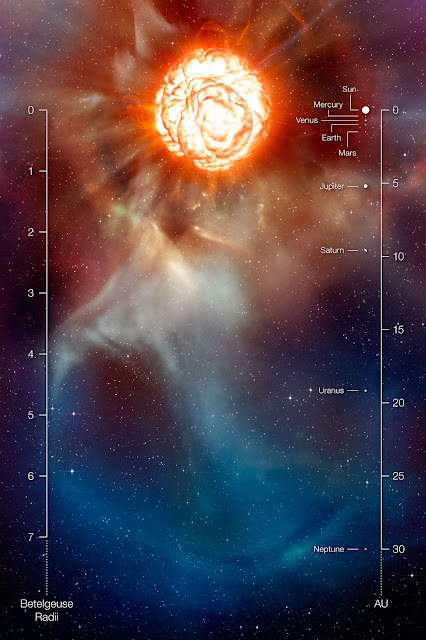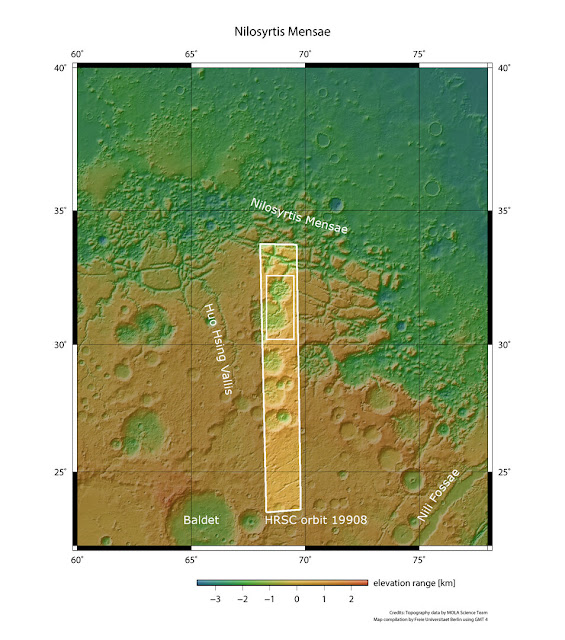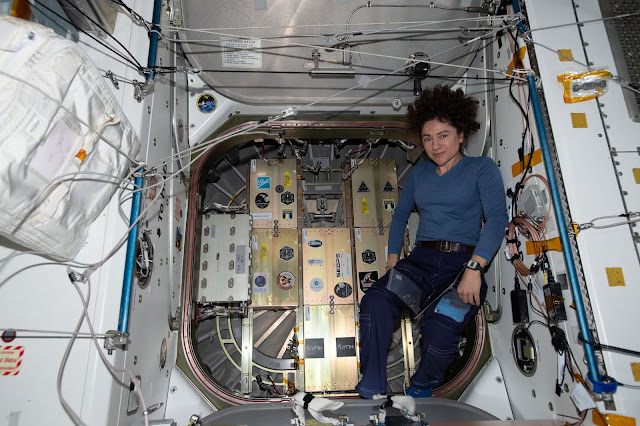ESO - European Southern Observatory logo.
14 February 2020
SPHERE’s view of Betelgeuse in December 2019
Using ESO’s Very Large Telescope (VLT), astronomers have captured the unprecedented dimming of Betelgeuse, a red supergiant star in the constellation of Orion. The stunning new images of the star’s surface show not only the fading red supergiant but also how its apparent shape is changing.
SPHERE’s view of Betelgeuse in January 2019
Betelgeuse has been a beacon in the night sky for stellar observers but it began to dim late last year. At the time of writing Betelgeuse is at about 36% of its normal brightness, a change noticeable even to the naked eye. Astronomy enthusiasts and scientists alike were excitedly hoping to find out more about this unprecedented dimming.
Betelgeuse before and after dimming
A team led by Miguel Montargès, an astronomer at KU Leuven in Belgium, has been observing the star with ESO's Very Large Telescope since December, aiming to understand why it’s becoming fainter. Among the first observations to come out of their campaign is a stunning new image of Betelgeuse’s surface, taken late last year with the SPHERE instrument.
Betelgeuse’s dust plumes seen by VISIR image
The team also happened to observe the star with SPHERE in January 2019, before it began to dim, giving us a before-and-after picture of Betelgeuse. Taken in visible light, the images highlight the changes occurring to the star both in brightness and in apparent shape.
A plume on Betelgeuse (artist’s impression with annotations)
Many astronomy enthusiasts wondered if Betelgeuse’s dimming meant it was about to explode. Like all red supergiants, Betelgeuse will one day go supernova, but astronomers don’t think this is happening now. They have other hypotheses to explain what exactly is causing the shift in shape and brightness seen in the SPHERE images. “The two scenarios we are working on are a cooling of the surface due to exceptional stellar activity or dust ejection towards us,” says Montargès [1]. “Of course, our knowledge of red supergiants remains incomplete, and this is still a work in progress, so a surprise can still happen.”
The star Betelgeuse in the constellation of Orion
Montargès and his team needed the VLT at Cerro Paranal in Chile to study the star, which is over 700 light-years away, and gather clues on its dimming. “ESO's Paranal Observatory is one of few facilities capable of imaging the surface of Betelgeuse,” he says. Instruments on ESO’s VLT allow observations from the visible to the mid-infrared, meaning astronomers can see both the surface of Betelgeuse and the material around it. “This is the only way we can understand what is happening to the star.”
Zooming in on Betelgeuse
Another new image, obtained with the VISIR instrument on the VLT, shows the infrared light being emitted by the dust surrounding Betelgeuse in December 2019. These observations were made by a team led by Pierre Kervella from the Observatory of Paris in France who explained that the wavelength of the image is similar to that detected by heat cameras. The clouds of dust, which resemble flames in the VISIR image, are formed when the star sheds its material back into space.
Betelgeuse before and after dimming (animated)
“The phrase ‘we are all made of stardust’ is one we hear a lot in popular astronomy, but where exactly does this dust come from?” says Emily Cannon, a PhD student at KU Leuven working with SPHERE images of red supergiants. “Over their lifetimes, red supergiants like Betelgeuse create and eject vast amounts of material even before they explode as supernovae. Modern technology has enabled us to study these objects, hundreds of light-years away, in unprecedented detail giving us the opportunity to unravel the mystery of what triggers their mass loss.”
From Betelgeuse’s surroundings to its surface
Notes:[1] Betelgeuse's irregular surface is made up of giant convective cells that move, shrink and swell. The star also pulsates, like a beating heart, periodically changing in brightness. These convection and pulsation changes in Betelgeuse are referred to as stellar activity.
More information:The team is composed of Miguel Montargès (Institute of Astronomy, KU Leuven, Belgium), Emily Cannon (Institute of Astronomy, KU Leuven, Belgium), Pierre Kervella (LESIA, Observatoire de Paris - PSL, France), Eric Lagadec (Laboratoire Lagrange, Observatoire de la Côte d'Azur, France), Faustine Cantalloube (Max-Planck-Institut für Astronomie, Heidelberg, Germany), Joel Sánchez Bermúdez (Instituto de Astronomía, Universidad Nacional Autónoma de México, Mexico City, Mexico and Max-Planck-Institut für Astronomie, Heidelberg, Germany), Andrea Dupree (Center for Astrophysics | Harvard & Smithsonian, USA), Elsa Huby (LESIA, Observatoire de Paris - PSL, France), Ryan Norris (Georgia State University, USA), Benjamin Tessore (IPAG, France), Andrea Chiavassa (Laboratoire Lagrange, Observatoire de la Côte d'Azur, France), Claudia Paladini (ESO, Chile), Agnès Lèbre (Université de Montpellier, France), Leen Decin (Institute of Astronomy, KU Leuven, Belgium), Markus Wittkowski (ESO, Germany), Gioia Rau (NASA/GSFC, USA), Arturo López Ariste (IRAP, France), Stephen Ridgway (NSF’s National Optical-Infrared Astronomy Research Laboratory, USA), Guy Perrin (LESIA, Observatoire de Paris - PSL, France), Alex de Koter (Astronomical Institute Anton Pannekoek, Amsterdam University, The Netherlands & Institute of Astronomy, KU Leuven, Belgium), Xavier Haubois (ESO, Chile), Eric Pantin (CEA, France), Ralf Siebenmorgen (ESO, Germany).
The VISIR image was obtained as part of the NEAR science demonstration observations. NEAR (Near Earths in the AlphaCen Region) is an upgrade of VISIR, which was implemented as a time-limited experiment.
ESO is the foremost intergovernmental astronomy organisation in Europe and the world’s most productive ground-based astronomical observatory by far. It has 16 Member States: Austria, Belgium, the Czech Republic, Denmark, France, Finland, Germany, Ireland, Italy, the Netherlands, Poland, Portugal, Spain, Sweden, Switzerland and the United Kingdom, along with the host state of Chile and with Australia as a Strategic Partner. ESO carries out an ambitious programme focused on the design, construction and operation of powerful ground-based observing facilities enabling astronomers to make important scientific discoveries. ESO also plays a leading role in promoting and organising cooperation in astronomical research. ESO operates three unique world-class observing sites in Chile: La Silla, Paranal and Chajnantor. At Paranal, ESO operates the Very Large Telescope and its world-leading Very Large Telescope Interferometer as well as two survey telescopes, VISTA working in the infrared and the visible-light VLT Survey Telescope. Also at Paranal ESO will host and operate the Cherenkov Telescope Array South, the world’s largest and most sensitive gamma-ray observatory. ESO is also a major partner in two facilities on Chajnantor, APEX and ALMA, the largest astronomical project in existence. And on Cerro Armazones, close to Paranal, ESO is building the 39-metre Extremely Large Telescope, the ELT, which will become “the world’s biggest eye on the sky”.
Links:ESOcast 217 Light: ESO Telescope Sees Surface of Dim Betelgeuse
https://www.eso.org/public/videos/eso2003a/Photos of the VLT:
http://www.eso.org/public/images/archive/category/paranal/ESO's Very Large Telescope (VLT):
https://www.eso.org/public/teles-instr/paranal-observatory/vlt/SPHERE instrument:
https://www.eso.org/public/teles-instr/paranal-observatory/vlt/vlt-instr/sphere/VISIR instrument:
https://www.eso.org/public/teles-instr/paranal-observatory/vlt/vlt-instr/visir/Images, Text, Credits: ESO/Bárbara Ferreira/LESIA, Observatoire de Paris - PSL/Pierre Kervella/Institute of Astronomy, KU Leuven/Emily Cannon/FWO [PEGASUS]² Marie Skłodowska-Curie Fellow / Institute of Astronomy, KU Leuven/Miguel Montargès/ESO/M. Montargès et al./ESO/P. Kervella/M. Montargès et al., Acknowledgement: Eric Pantin/ESO/L. Calçada/IAU and Sky & Telescope/Videos: ESO/P. Kervella/M. Montargès et al., Digitized Sky Survey 2. Acknowledgement: Eric Pantin, N. Risinger (skysurvey.org). Music: Johan B. Monell (www.johanmonell.com).
Best regards, Orbiter.ch



















































